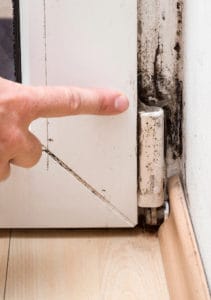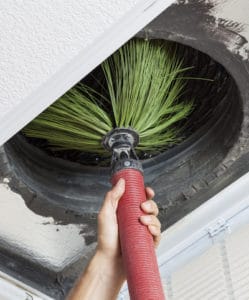
House-hunting? Then keep those allergy triggers in mind. Learn what to watch for, what can be fixed – and when to shorten your shortlist.
When Jennifer Moss went searching for a new home, she followed her nose. Like many looking to relocate, the creative writing instructor and podcast producer was seeking all the usual perks for herself and her family. She wanted a place with character and charm, enough room for her kids, a nice yard and a good neighborhood. But because of an allergy, Moss had one more key must-have: a home that was essentially mold-free.
“I would walk into a house, and the real estate agent would start talking about the features – how many bathrooms, what kind of floors. But if there was mildew in the basement, I would know in about 30 seconds. I would just be like, ‘No, I couldn’t live here,’” says Moss, a Vancouver resident.
“At a certain point I thought maybe I could rent myself out to home-buyers as a sort of bloodhound for mildew,” she adds with a laugh.
Michaela Smith knows that feeling all too well. The 29-year-old was relocating from Colorado Springs to Denver, and needed to find a room in a shared home. But it needed to be a place that was clean, pet-free, smoke-free, and where housemates wouldn’t use perfumes and chemical cleaners that would trigger her symptoms.
“I thought it would be easy to find a place, but I probably contacted more than a hundred places,” she recalls. Many of the homes sounded promising, but when she arrived, she would smell irritants like incense or marijuana and be forced to leave. One spot seemed like a perfect fit, but shortly after she stepped through the door, she started to react.
“I had really, really itchy eyes. The woman was saying, ‘What do you think?’ And I said, ‘I just need a minute to see what’s going on,’” recounts Smith. Again and again she found herself having to explain her allergies to prospective roommates. “To be in that situation is just really uncomfortable, and on many levels.”
Allergy House-Hunting
Because there are so many potential triggers, looking for a home can be especially tough for people with allergies and asthma, says Dr. Jay Portnoy, a pediatric allergist at Children’s Mercy Kansas City, and professor of pediatrics at the University of Missouri-Kansas City.

even musty smells.
If people opt for a new house or condo, they could face significant off-gassing from volatile organic compounds in new carpeting, cabinetry, paints, adhesives, insulation and other building materials. Those VOCs are notorious respiratory irritants. Resale homes come with a different set of potential allergy-provoking hazards. Among them are mold, dust mites, rodent droppings, cigarette smoke and VOCs from renovations.
One of the most problematic, and the most persistent, is pets. If the previous owner or tenant had a cat or a dog, they might have left a hefty dose of dander behind. “Cat allergen in particular can stay around for a long while. It doesn’t spontaneously decay very quickly,” explains Portnoy. “It can take up to six months to drop by half of its potency.”
The Nose Knows Allergy Triggers
Real estate open houses are full of distractions, from chatty realtors to fancy new fixtures. So Portnoy recommends preparing a checklist of potential triggers in advance of viewings, then carefully running through it on site.
Keep a close eye out for any signs of structural issues or water intrusion, such as stains on ceilings or walls, bulging drywall, leaky faucets or musty smells. Moisture issues can encourage mold growth, insect and rodent infestations and other allergy-aggravating issues.
“If you see evidence of leakage, you need to ask about that. When did that occur? What was done to repair it? Has the leak been resolved?” says Portnoy, who strongly recommends hiring a home inspector, ideally one who has training in tracking down mold. House hunters like Moss and Smith are also wise to put their own senses to work.
“You should use your nose. If you walk into a house and it smells moldy, there’s a mold problem somewhere and I would think twice about buying it,” he says. “In the summer, a lot of basements have a bit of a mold smell, usually from condensation, and a dehumidifier will often take care of it, so that wouldn’t necessarily disqualify a house. But if you’re up in the living space and it smells moldy, that’s a sign something’s wrong.”
Pets and Pests
Pet dander in the home isn’t necessarily a deal breaker for people with pet allergies, says Portnoy, but the new owners or renters should be prepared to do a big clean that includes washing down walls, carefully vacuuming or ideally removing carpets, changing furnace and air conditioner filters, and getting air ducts professionally cleaned. (Homes with radiant heat get bonus points since they don’t have forced air blowing allergens around.)

“A home that has had cats in it is not going to be cat-free for a number of months after the cat has left, even with those aggressive moves – but these actions can speed up the rate at which the cat allergen is removed,” explains Portnoy. While dog dander can be equally problematic for some, he says it’s not as persistent as cat allergen. “And because pet allergens stay airborne for a long period of time, it may be necessary to use an air filtration unit.”
When checking out places, also look for signs of rodent or insect infestations, advises Portnoy. Not only do they make for unpleasant cohabitants, their feces are potent allergens. Check corners, along windowsills and under sinks for signs of rodent droppings or cockroach frass, which looks like fine dirt, and keep an eye out for mouse or insect traps – a telltale sign that there could still be a problem.
“You might want to ask if there’s a history of infestation, and you could have your own exterminator take a look,” he says. “If you see a lot of insecticides under the sink or rat-killing materials, there’s a reason they’re there. Ask, ‘Why are there mousetraps? Have they served their purpose?’”
A New Dilemma
New homes and condos can be tempting, since buyers can avoid issues like pet dander and mold that previous occupants leave behind. But if you notice a “new home smell,” it’s likely the chemicals off-gassing from paints, adhesives, carpets and cabinets.
Ask the realtor or property manager for a list of materials used, and find out if they were no-VOC or low-VOC. If not, you might want to think twice before signing on the dotted line, especially if you or a family member finds chemicals to be an asthma or allergy trigger. But if you end up taking the leap, Portnoy recommends using the home’s air system, as well as kitchen and bath fans, to keep fresh air coming in and VOCs going out.
Beware the Quick Fix
Dr. Kanao Otsu, assistant professor of medicine in the Division of Allergy and Immunology at National Jewish Health in Denver, agrees that structural issues and major moisture problems are the primary deal breakers for allergic home hunters – unless they’re prepared to tackle a big reno. (If it’s just a musty old carpet, though, that’s a relatively easy fix.)
Going from one viewing to the next can itself be hazardous, she notes, so taking an antihistamine in advance can be a good idea to help keep reactions from allergy triggers at bay.
With asthma and pet allergies, Otsu recommends pre-treating with your reliever inhaler. “Before you walk into the house, you can take two puffs of the rescue inhaler to help prevent an asthma attack.”
If you’re looking in an apartment or condo building where people live in close quarters, find out about venting if there’s a pet next door. Also ask if there have been plumbing problems, or issues with pests, and whether they have been fully fixed. “Ask if they have been remediated, or if there have been recurrences. Those are the things that are harder to control because in a shared building, you can’t control other people’s behavior that might impact your health,” she says.
With things like plumbing repairs, “make sure it wasn’t just a cosmetic fix, that they didn’t just cover up a wall stain with paint to make it look pretty,” she adds. “I would ask the realtor, and get those answers before committing.”
Home Sweet Home
It took a lot of sleuthing, and sniffing, but in the end both Moss and Smith found homes they love. Moss and her family have settled into a 1937 heritage home in Vancouver. It has plenty of charm and no signs of moisture intrusion or cracks in the foundation.
Smith moved in with a senior who is respectful of her health concerns, and doesn’t use any products that trigger her symptoms. “I’m grateful every single day,” she says. “It’s wonderful.”
She recommends asking plenty of questions and, when it comes to shared housing, not being shy about making your needs clear. Downplaying problems might lead to issues later on. If you’re buying, also inform your realtor and home inspector of your allergy triggers or asthma, so they can help find the most suitable spot.
Before Moss and her family moved into their home, they replaced the shag carpet with hardwood, and used non-toxic paint to cover over the sunset orange faux finish on the walls. (“I was allergic to the color,” she quips.) They also had the vents cleaned, and swapped out curtains for hard-surface blinds.
“We made the right choice, although it wasn’t even really a choice. If you feel like your throat is closing up, don’t live there. It boils down to that,” says Moss, who was especially careful to avoid places that showed signs of moisture.
“I mean, if you’re a contractor and think you have the chutzpah to dig out the basement, pour a new foundation, put it in all new windows and drywall, fine,” she says with a laugh. “But if you’re not that person, then don’t buy that house.”
Related Reading
Moving In: 6 Tips For Doing The Big Clean
15 Easy Jobs for Better Breathing with Asthma and Allergies
Allergic Living’s Go-To Goods for Renovating with Environmental Allergies





